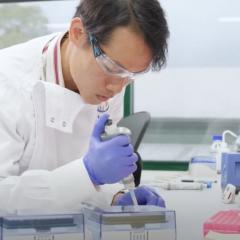
An international research collaboration has revealed clusters or ‘hotspots’ of genetic mutations known as ‘tandem duplications’ may contribute to the growth of breast cancer.
Dr Peter Simpson and Professor Sunil Lakhani from The University of Queensland’s Centre for Clinical Research (UQCCR) were part of the study analysing the genomes of 560 breast cancers.
The UQCCR team collected breast cancer tissue samples in a local collaboration with colleagues from Pathology Queensland and the Royal Brisbane and Women’s Hospital to provide 30 Australian patient samples.
Dr Simpson said the large-scale sequencing study revealed new insight into the causes of breast cancer.
“The research looked at mutations called ‘tandem duplications’,” Dr Simpson said.
“Every healthy cell in the human body has two copies of each gene, one from the mother and one from the father.
“A tandem duplication is where a section of the DNA is copied and then inserted back into the genome next to the original stretch of DNA.
“This creates a situation where there are extra copies of some genes in the genome.”
Dr Simpson said tandem duplication was not a new concept but the research showed it was occurring in genes or regions of the genome not previously suspected of being involved in breast cancer.
“It could also be acting as an alternative mechanism of activating previously recognised cancer driver genes,” Dr Simpson said.
Professor Lakhani said the study found 33 regions of the genome where these mutations happen in multiple patient samples.
“This indicates that these are unlikely to happen by chance and may therefore act as ‘driver’ mutations to cause cancer.
“This level of detail gives us fundamental knowledge of how a tumour arises, the mechanisms that underpin these mutations and potential targets for therapy.”
The research is published in Nature Genetics.
Media: Dr Peter Simpson, p.simpson@uq.edu.au, Professor Sunil Lakhani, s.lakhani@uq.edu.au ; Bernadette O’Connor (UQ Media), bernadette.oconnor@uq.edu.au, +61 7 3365 5118, 0431 533 209.



